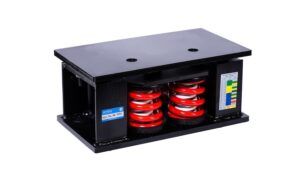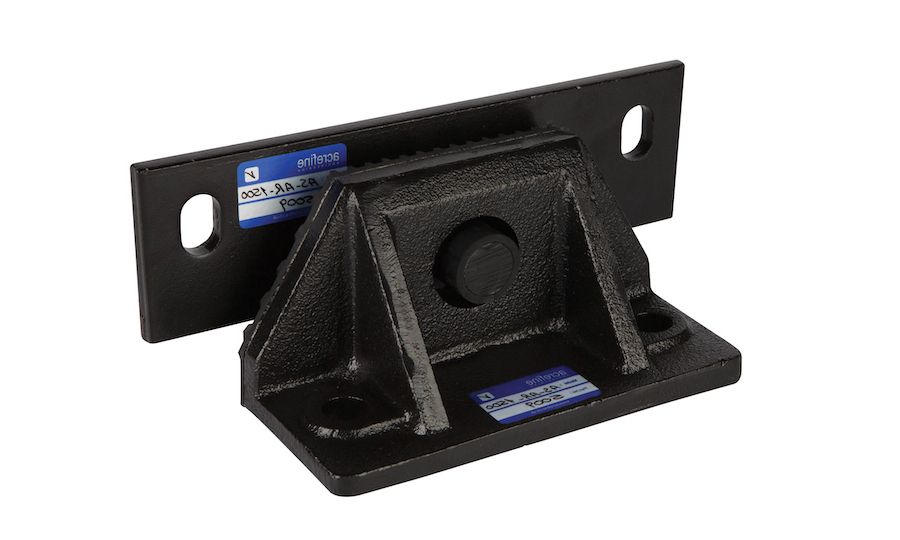Seismic Restraints for HVAC Equipment
Seismic restraint products are in three groups; seismic isolators, seismic snubbers and seismic bracing. Based on the vibration isolation component seismic isolators can be rubber or spring type.
Seismic snubbers are relatively simple components that come in various types and sizes. Acrefine offers steel cable bracing, which has versatile use. Designers created all these products to limit the movement of non-structural components during earthquakes or high winds.
Read below for more information and watch step-by-step installation videos on our YouTube Channel.
Earthquakes and high winds can cause significant damage in many different ways to structures of all types. However, the damage that natural disasters can cause to electrical and mechanical systems in buildings can be especially extensive.
You must properly secure and hold mechanical electrical systems in place, especially. If building movement knocks equipment off its supporting structure, it can threaten both property and lives.
Considering this, it’s obvious that properly securing seismic equipment is not expensive. Securing equipment and products can save money by preventing the need for repairs or replacements. It can also save time by avoiding downtime caused by earthquakes.
At Acrefine, we offer products that undergo testing and certification to meet the ASCE and IBC International Building Code. These products help prevent equipment from moving during earthquakes, keeping it safe. Using our systems correctly will reduce risks and lower long-term repair costs.
Seismic Restraint for Nonstructural Components
Three types of seismic restraints are available for non-structural components. These include seismic cable, seismic isolators, and seismic snubbers. All perform the same task of restraining equipment during a seismic event. However, they achieve this goal in different ways.
Seismically restrained vibration isolators may be either spring or rubber types. Meanwhile, a seismic snubber is a fairly simple component available in several sizes and types.
Here at Acrefine, we also offer seismic cable bracing products based on a steel wire rope construction. These are versatile to use with suspended equipment and piping. We design our products in accordance with building codes.
Seismic Isolators | Vibration Isolation and Life Safety
A Seismic Isolator, or more precisely Seismically Restrained Vibration Isolator, may either be a rubber or spring type. It doesn’t need a seismic snubber because it has a ductile steel housing that restrains movement in all directions. Isolators with a spring and top plate or stud are most commonly used.
Choose seismic isolators with a top plate to secure large equipment like cooling towers, generators, or chillers. That is because these isolators are capable of handling extremely heavy weights and provide optimal isolation. They’re also more suitable for resisting large seismic forces.
For fans, pumps, and other small equipment, stud isolators offer better prices. These have a more limited load capacity, but offer good isolation and excellent seismic load performance.
A seismic rubber isolator is a better choice for applications which require high-frequency isolation. They are also suitable in areas that are less sensitive to vibration or noise.
Seismic Isolators with Top Plate for Heavy HVAC Equipment
These spring type seismic isolators achieve isolation by using springs sandwiched between bottom and top plates. Their steel housing gives protection from earthquakes by resisting the seismic forces in every direction. These isolators’ most distinctive feature is a top plate. With these, it is easy to place beams or equipment bases in position.
For low-frequency vibrations, it is important to use large deflection springs, which can only fit in these isolators. Also, several spring layouts fit in one housing to isolate extremely heavy equipment. Diesel generators, cooling towers, chillers, transformers and similar equipment usually require these type of isolators.
What are Seismic Isolators with a Single Stud?
These spring type seismic isolators achieve isolation by using one spring inside a ductile steel housing. This gives optimal protection from earthquakes because of its ability to resist seismic forces in every direction.
These isolators have a distinctive feature; you can install the support or equipment base directly to the single stud. No need for any extra nuts and bolts or welding is a bonus.
Hence isolating low-frequency vibrations require large deflection springs, these products usually suit medium or small equipment. Small chillers, pumps, and fans are all suitable for use with a single stud isolator.
When are Seismic Isolators with Rubber Mounts used?
A seismic rubber isolator limits equipment movement in every direction caused as a result of seismic forces. It consists a steel housing around the rubber mount, which has an embedded steel insert to for bolted joint to the equipment base. This way, it offers an all-directional restraint system for both vertical and lateral forces.
Shore A Hardness is the parameter to group the rubber elements used in this type of seismic isolator. This corresponds to their varying load ranges. Medium and small mount sizes have three groups, namely 40, 50 and 60 Shore A hardness, and the load capacity is up to 900kg.
Seismic Protection with Snubbers
A seismic snubber is the most commonly-used protection from damage to mechanical equipment and electrical equipment. Seismic snubbers are available in several different sizes and shapes. However, all have a load resisting surface with a special protective rubber layer.
Commonly, these items are perfect to use together with a vibration isolation product such as spring mounts or pads. If there are no concerns about isolation, a seismic snubber act alone as a restraint. They are capable of resisting seismic forces either in multiple or single directions.
Seismic Bracing for Piping Systems and Beyond
In this category, two distinct types of products are ” galvanized steel ” wire rope and rigid. Single rigid elements are capable of working either under compression loading or tension. They’re ideal to protect suspended MEP services, mechanical and electrical equipment:
- Fire protection and MEP piping
- HVAC duct
- Cable trays
- AHU
- FCU
- Fans
- Indoor units
- Other mechanical and electrical components
Steel wire rope option is a cost-effective solution even if they’re only capable of resisting tension loads. A single seismic restraint point require two of them on both sides. But the design and installation costs are far more less compared to rigid method.
Rigid method is only suitable for use if isolation won’t be necessary. They also require rod stiffeners regardless of the rod length, to prevent buckling. The only available alternative in such cases will be steel wire ropes. They’re speedy to install while also offering excellent flexibility.
Here at Acrefine, we supply an extensive range of high-quality seismic restraint products to suit every need. Whether you need seismic cable, seismic snubbers, or seismic isolators, we have the solution you’re looking for.



